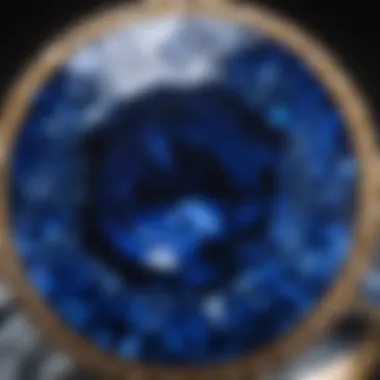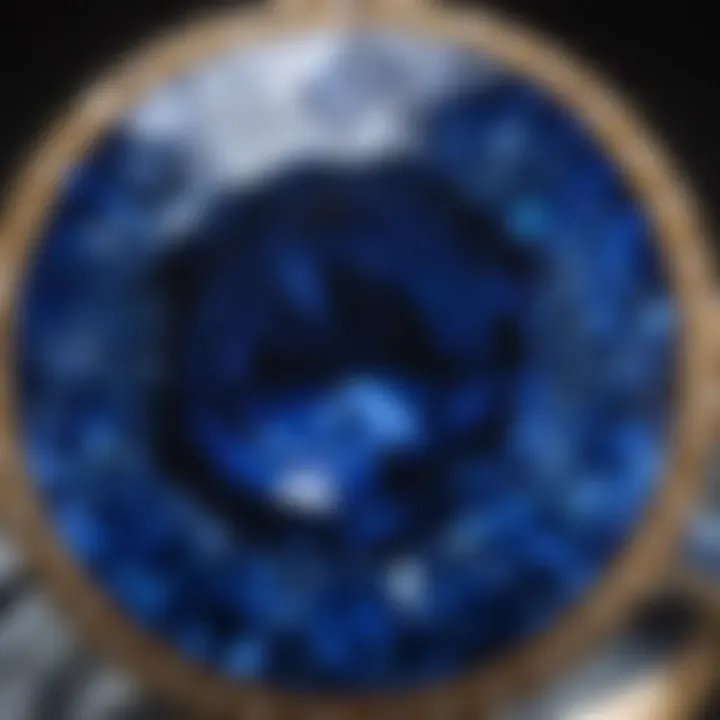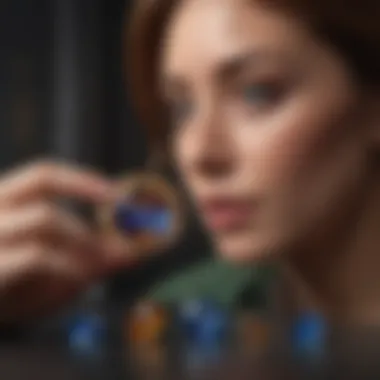Discovering the Rich Diversity of Colored Sapphires


Intro
Colored sapphires have captured the imagination of jewelry enthusiasts, collectors, and researchers alike. Known primarily for their vivid blue shades, these gemstones also exist in a striking variety of colors, each with its own unique charm and significance. This article takes a closer look at colored sapphires, exploring their deep-rooted history, remarkable properties, and the intricate market trends that affect their value.
Since ancient times, sapphires have held a place of reverence in various cultures. From the royal jewels of Europe to the sacred artifacts in Asia, these stones symbolize virtue, wisdom, and divine favor. Understanding these colorful gems opens a pathway not just to their beauty but also to their cultural narratives, value in modern markets, and the ethical implications surrounding their extraction.
In this journey, we will dissect various aspects of colored sapphires. To start, it's crucial to grasp what exactly defines these gemstones.
Gemstone Overview
Definition and characteristics
Sapphires come from the mineral corundum, primarily composed of aluminum oxide, and they are known for their hardness, rating a 9 on the Mohs scale. Interestingly, the presence of trace elements transforms the corundum's color. For instance, iron and titanium lend their influence for the classic blue, while chromium introduces a beautiful pink, and iron can yield yellow and green hues. This versatility in hues makes sapphires extraordinarily unique within the gemstone community.
Notably, the term "fancy sapphires" covers all colors except blue, allowing for an extensive palette—purple, green, orange, and even color-changing varieties. The color spectrum is not merely a feast for the eyes but also serves as an essential factor in determining each stone's value and desirability.
Classification of gemstones
Gemstones undergo various classifications based on specific criteria. The most common distinctions include:
- Precious Gemstones: This category typically encompasses diamonds, rubies, emeralds, and sapphires. Notably, their rarity and historical significance elevate them above others.
- Semi-Precious Gemstones: While these are still beautiful, they lack the same level of rarity and cultural importance as their precious counterparts. Examples include amethyst, turquoise, and garnet.
- Organic Gemstones: Constructs of biological origins, such as pearls and amber, fit within this classification, showcasing a fascinating complexity.
Determining the classification can often be subjective, resting on cultural values as well as market trends.
Properties of Gemstones
Physical properties
Colored sapphires stand out with various physical properties that contribute to their allure. For example, the gem's brilliance—a combination of its refractive index and cut quality—enhances its visual appeal. A well-cut sapphire will reflect light effectively, creating a dazzling sparkle.
The durability of sapphires is another essential attribute. As one of the hardest gemstones, colored sapphires can withstand the rigors of everyday wear. The hardness ratings significantly influence their applications in jewelry; they are ideal choices for engagement rings and other frequently-worn pieces.
Chemical properties
Chemically, sapphires are quite stable, which aids in their enduring beauty. Their resistance to chemicals and scratching means that they remain lustrous and vibrant over time. However, it’s crucial to avoid exposure to harsh cleaning agents that might diminish their polish. Additionally, understanding the chemical makeup can help in identifying potential treatments, as many colored sapphires undergo enhancements to improve their color.
"Knowledge of a sapphire's chemical and physical properties empowers buyers to make informed decisions while investing in these precious gems."
Through this exploration of various facets of colored sapphires, we start to see not just their beauty, but the rich tapestry of history, culture, and value interwoven within. Next, we will dive deeper into the origins and significance of different colored sapphires, unpacking the stories and trends that shape their desirability.
Prolusion to Sapphires
Sapphires are often viewed through a lens of beauty and luxury. However, the world of these gemstones extends beyond mere aesthetics. Understanding what defines a sapphire is crucial, as it adds depth to the appreciation of these glorious stones. This section introduces readers to the fascinating realm of sapphires, setting the stage for an exploration of their varied colors, properties, and cultural significance.
What Defines a Sapphire?
At its core, a sapphire is a precious gemstone belonging to the corundum family, characterized by its unique composition. While blue sapphires are the most recognized, sapphires can occur in multiple colors, barring red, which is classified exclusively as ruby. The beauty of a sapphire lies in its ability to display a vast array of hues, from the softest pink to the richest yellow and beyond.
A key defining aspect is their hardness, scoring a robust 9 on the Mohs scale, just shy of diamond at 10. This incredible hardness makes them ideal for all types of jewelry, from engagement rings to timeless heirlooms.
The magical allure of sapphires is perhaps most enchanting when you delve into their cultural and historical significance. Sapphires have adorned crowns and religious artifacts throughout the ages, each piece carrying stories of power, grace, and mystery. Each color option presents its own narrative, inviting collectors and enthusiasts alike to tap into its emotional and symbolic resonance.
The Role of Corundum
Corundum, a mineral comprised primarily of aluminum oxide, is the backbone of all sapphires. Its chemical and structural properties create the necessary conditions for these gemstones to develop their stunning colors.
Trace elements like iron, titanium, chromium, and copper play a pivotal role in defining the gemstone’s final appearance. For instance, the presence of iron and titanium can lead to a deep blue hue, while chromium is responsible for the vibrant pink and red shades. The interplay of these trace elements transforms ordinary corundum into extraordinary sapphires, where each gem tells a story of geological and environmental conditions unique to its origin.
Often, the purity of a sapphire can be gauged through its color saturation levels—essential for collectors seeking gems of the highest quality.
"Understanding the foundational elements that contribute to the sapphire's beauty is akin to reading the first pages of a gripping novel. It sets the tone for everything that follows."
As sapphires capture hearts worldwide, their significance grows, driven not only by their visual appeal but also by their composition—a blend of nature's artistry and geological history. This exploration is just the beginning, unraveling the complexity of colored sapphires as we dive deeper into the spectrum that encompasses this remarkable gemstone.
The Spectrum of Colored Sapphires
The realm of sapphires offers a dazzling array of colors, and understanding this spectrum is essential for anyone intrigued by gemstones. Diverse hues reveal not just aesthetic beauty but also geological stories, cultural significance, and varying values. Each color category encapsulates characteristics that can significantly influence market demands and personal preferences. By dissecting the various shades and their qualities, enthusiasts can appreciate the nuances that make colored sapphires not merely stones, but treasures of nature.
Blue Sapphires: The Classic Choice
Blue sapphires stand as the most recognizable and cherished within the sapphire family. Their iconically rich hue, often reminiscent of a twilight sky, has captivated hearts across cultures. The leading appeal lies in their association with nobility and luxury, enhancing the allure of engagement rings, statement pieces, and heirlooms. Notably, the coloring is primarily due to iron and titanium impurities. The specific combination of these elements leads to varying depths of blue, from light baby blue to the nearly black tones of deep indigo.
Key Considerations:
- Durability: Scoring a 9 on the Mohs scale, blue sapphires are highly resistant to scratches, making them ideal for everyday wear.
- Market Demand: The value can fluctuate notably based on saturation, clarity, and country of origin, with Kashmir and Burmese blue sapphires often commanding higher prices.
Pink and Purple Sapphires: A Romantic Palette


Pink and purple sapphires present a softer, more romantic option. With colors that transition from lush pink to vibrant violet, these sapphires evoke feelings of affection and creativity. The charm lies in their rarity, as certain shades of pink can rival even the best rubies. The formation of pink sapphires involves traces of chromium, which imparts that delicate rosy tint, while purple sapphires are influenced by iron and titanium.
Vital Insights:
- Symbolism: Pink sapphires often symbolize love and compassion, making them popular choices for anniversary gifts.
- Market Trends: The rise in popularity of pink and purple sapphires among contemporary designers highlights a move towards unique color preferences in jewelry.
Yellow and Orange Sapphires: Vibrancy and Warmth
Yellow and orange sapphires light up the spectrum with their vibrant, sunny hues. Yellow sapphires are often attributed to the presence of iron alone, while the orange variety results from a mixture of iron and chromium. These sapphires capture warmth and joy, making them whimsical choices for rings or pendants. They often provide a fresh alternative to more common gemstones, allowing wearers to express individuality.
Content Considerations:
- Brightness: The brighter the color, the more sought-after it tends to be, especially in yellow hues.
- Cultural Significance: In various cultures, yellow sapphires are believed to bring wealth and prosperity. This belief adds an intrinsic value for many collectors.
Green Sapphires: The Jewel of Nature
Green sapphires represent a connection to nature, embodying the spirit of the earth. Their shades can range from subtle pastel greens to dark forest hues, caused by varying amounts of iron and other trace minerals. This variation contributes to their unique appeal and potential rarity, especially with deeper colors. Green sapphires are less common and stand out for their rich appearance, which makes them intriguing choices for bespoke jewelry pieces.
Unique Highlights:
- Versatility: Many choose green sapphires for their versatile compatibility with both gold and silver settings.
- Environmental Connections: Symbolizing growth, harmony, and renewal, these stones resonate well with those seeking grounding energy in their jewelry.
Colorless Sapphires: An Understated Elegance
Colorless sapphires, often overshadowed, are a minimalist's dream. Though they lack overt color, they exude a certain elegance that can highlight the skill of a jeweler in cut and clarity. The aesthetic allows for a focus on the quality of craftsmanship, and when well-cut, these stones can rival diamonds in brilliance.
Noteworthy Points:
- Affordability: Colorless sapphires tend to be more affordable compared to their colored counterparts, offering a valuable option for those on a budget.
- Adaptability: Their neutral tone allows them to adapt well to any jewelry setting, from classic to modern designs.
Rare Colors: A Collector’s Dream
For avid collectors, rare-colored sapphires are the holy grail. These can include hues like padparadscha (a pink-orange blend), purple, or even rare greens and yellows that do not occur commonly in larger quantities. The availability of these stones can greatly influence their value in the market. Collectors often seek out such pieces, not only for their beauty but also for the stories of their origins.
Key Considerations:
- Investment Potential: Rare colors tend to appreciate over time, making them wise investments for collectors.
- Artistic Flair: Jewelry designers often gravitate towards rare shades, as these stones can translate into one-of-a-kind pieces that stand out in any collection.
Overall, the spectrum of colored sapphires is expansive and richly diverse. Each category, whether common or rare, carries its own story, value, and cultural significance that enriches the world of gemstones. Through a deeper understanding of these stones, collectors and enthusiasts can appreciate the layers of beauty that colored sapphires bring into both personal expressions and market dynamics.
The Science Behind Sapphire Colors
Understanding the science behind sapphire colors is crucial for anyone interested in these magnificent gemstones. The hues of sapphires are not merely a matter of personal preference or superficial beauty; they are a reflection of intricate chemical processes and geological phenomena. Engaging with this topic enlightens gemstone enthusiasts and collectors about what gives sapphires their unique colors. This knowledge can enhance both aesthetic appreciation and value assessment when it comes to purchasing or designing jewelry. Furthermore, insights into the science can inform ethical sourcing practices, ensuring that gemstones are mined and traded responsibly.
Trace Elements and Color Variations
At the heart of sapphire coloration lies the role of trace elements, which can significantly alter the appearance of these gemstones. Sapphires are primarily composed of corundum, a mineral made predominantly of aluminum oxide. However, it is the presence of trace elements that adds color to this otherwise clear stone.
When iron and titanium mix within the aluminum oxide structure, they create stunning blue sapphires. This particular pair of elements interacts in such a way that it absorbs certain wavelengths of light, reflecting back that characteristic deep blue tone we associate with high-quality sapphires. It's fascinating to consider that trace concentrations of iron can lead not just to vibrant blues, but also to muted greens and yellows, depending on their concentrations and combinations.
In contrast, chromium releases a vivid pinkish hue. It is the presence of this trace element that accounts for the beautiful rose and raspberry shades found in pink sapphires. It's a complex dance of chemistry, where even the slightest variation of these elements can lead to distinctive shade variations that can change the value and desirability of the gemstone. Notably, this element's subtlety makes the pink sapphire a favorite among those seeking something both romantic and unique.
"The rich diversity in color of sapphires is a treasure trove of natural history, reflecting the earth’s story through chemistry."
Other trace elements like magnesium and bismuth can produce colors such as yellow, orange, and green. Each pigment, albeit nuanced, plays a critical role in the gem's market appeal. The subtle play of colors can result in vast price differences, making this a significant factor for gem collectors and sellers. Just ask any seasoned jewelry designer—the presence of certain trace elements transforms the potential aesthetics and prices of their creations.
Color Change Phenomena
Color change phenomena in sapphires add an additional layer of intrigue behind their science. Some sapphires exhibit what’s called pleochroism, a fancy term that describes how a gem appears in different colors when viewed from different angles. This peculiar feature is often best seen in sapphires with a mix of trace elements, leading to dynamic palettes shifting from blue to violet or even purple. Such visual complexities can enchant buyers, as they provide a sense of depth and variability to the gemstone's visual presentation.
Another remarkable variant of color change is known as the alexandrite effect. In some gems, primarily a specific category of sapphires found in certain locations, the stone’s color shifts dramatically depending on the light source. Under daylight, a sapphire might present a bluish hue, while under incandescent light, it could transform into a warm purple. This duality enhances the stone's allure and intricacy, making it a prized possession for those in the know.
Understanding the science of color change isn't just about aesthetics; it has practical ramifications. Such sapphires tend to command premium prices in the market, often appealing to collectors and investors. Every new discovery about these color-changing gems adds to their mystique and value—further solidifying their place as extraordinary wonders of nature.
In summary, examining the chemistry and phenomena behind sapphire colors enriches our appreciation and understanding of these complex gems. Whether through individual nuances like trace elements or fascinating traits like pleochroism, the science behind sapphire colors offers a window into the earth’s ancient treasures.
Value and Rarity in the Sapphire Market
The world of colored sapphires is not just vibrant but also intricate when it comes to value and rarity. Understanding these aspects is essential for anyone interested in acquiring sapphires, whether for personal collection or investment. The market for sapphires is influenced by various factors that shape their desirability, making it vital for buyers and enthusiasts to grasp these nuances.
Factors Influencing Sapphire Value
When evaluating sapphire value, several key elements come into play:


- Color Quality: The saturation and hue of the sapphire significantly impact its worth. Rich, vivid colors, particularly in blue and pink sapphires, command premium prices.
- Clarity: A clear sapphire—one with minimal inclusions—will generally hold more value than one that's cloudy or has visible defects. Buyers often seek stones referred to as "eye-clean," meaning no imperfections can be seen without magnification.
- Cut: The craftsmanship of the sapphire’s cut affects both its brilliance and aesthetic appeal. Well-cut stones reflect light beautifully and enhance the overall visual attractiveness.
- Carat Weight: Larger sapphires tend to be rarer and thus more expensive. Though the value doesn’t scale linearly with size, significant increases in weight usually lead to much higher prices.
- Origin: Certain regions are known for producing exceptional sapphires, such as Kashmir, Myanmar, and Sri Lanka. Sapphires from these areas often carry a premium due to their historical significance and unique characteristics.
Each of these factors contributes to the overall market value of a sapphire, making it crucial for buyers to consider them when shopping.
Market Trends and Demand
The market for sapphires is dynamic, influenced by trends that shift over time. Current market observations highlight:
- Increased Interest from Collectors: With the rise in popularity of colored stones, collectors are actively seeking unique and rare specimens. This growing demand drives prices upward, especially for rare hues like violet or yellow sapphires.
- Sustainability and Ethics: Many buyers are now prioritizing ethically sourced gemstones. As a result, sapphires that come with certifications of fair trade or sustainability are attracting significant attention and often fetch higher prices.
- Fashion Trends: The influence of fashion can’t be overlooked. As celebrities and influencers showcase sapphire jewelry, public interest swells. This visibility can lead to spikes in demand for certain colors or styles, impacting prices.
- Investment Potential: As the sapphire market matures, many view these gems as viable investments. With the right knowledge and timing, buyers can capitalize on their potential to appreciate in value over time.
Understanding these trends can provide insight into the future landscape of the sapphire market. As collectors and enthusiasts navigate through these waters, knowledge of both the contributing factors to value and the evolving market dynamics becomes invaluable.
"In the realm of colored sapphires, rarity isn’t just a matter of availability; it’s about the unique characteristics that stand apart from the ordinary."
In summary, the interplay between these various elements creates a complex tapestry that defines the value and rarity of colored sapphires. For anyone involved in the sapphire market, staying informed on these factors is the key to making educated decisions, be it for personal enjoyment or investment strategy.
Identifying Quality Sapphires
Understanding how to identify quality sapphires is crucial for both gem enthusiasts and serious collectors. The allure behind these stones often hinges not just on aesthetics but also on intrinsic value dictated by clarity, cut, and carat weight. Knowing what to look for can make a significant difference not just in acquisition but also in appreciation of these gems in their myriad hues.
Clarity, Cut, and Carat Weight
When discussing sapphires, clarity is a linchpin. The term refers to the presence of inclusions or internal flaws within the stone, which can affect its visual appeal and, ultimately, its worth. Generally, a flawless sapphire fetches a premium, but minor inclusions can sometimes lend uniqueness to the stone, telling a story of its formation.
Cut also plays a pivotal role in a sapphire's brilliance. The skill with which the stone is cut can enhance its light return and therefore its overall sparkle. A well-cut sapphire reflects light beautifully, while a poorly cut stone may appear dull or lifeless.
Then there's carat weight—an obvious factor yet often misconstrued. Heavier doesn't always mean better. A one-carat sapphire of high quality can sometimes outshine a larger carat stone if the latter compromises on clarity or cut. Thus, the trifecta of clarity, cut, and carat weight should be assessed holistically rather than in isolation.
"In the world of gemstones, the perfect combination of clarity, cut, and carat weight can elevate a sapphire from ordinary to extraordinary."
Certification and Appraisal
Certification has become indispensable in the sapphire marketplace. When sourcing sapphires, one should consider obtaining a certification from reputable gemological laboratories such as the Gemological Institute of America (GIA) or the International Gemological Institute (IGI). These entities employ rigorous standards for testing and can compare a sapphire's characteristics to a globally recognized grading scale.
An appraisal not only establishes a gemstone’s market value but also serves as documentation for insurance purposes, should anything happen to it. Appraisals assess criteria such as origin, treatment, and overall quality based on the established parameters of clarity, cut, and carat weight.
Thus, potential buyers and collectors should always seek certified and appraised gemstones to safeguard their investments. This diligence can save headaches down the road, ensuring that the piece of jewelry being cherished is indeed worthy of its cost.
Ethics in Sapphire Sourcing
The conversation surrounding Ethics in Sapphire Sourcing involves more than just the rocks themselves; it's a complex web interweaving socio-economic contexts, environmental sustainability, and issues of exploitation. As gemstone enthusiasts, collectors, and designers, understanding these dynamics is crucial. It shapes not only the market but also the narratives woven into each sapphire you admire.
Understanding Ethical Sourcing
Ethical sourcing refers to the practice of procuring gemstones in a way that honors sustainable methods, fair labor practices, and community welfare. In the world of colored sapphires, this concept is gaining momentum. It's about accountability in the supply chain, ensuring that the miners and workers receive fair compensation for their labor while working under safe conditions. Many long-standing issues in this field include child labor, dangerous working scenarios, and lack of fair income—issues that have historically plagued the gemstone industry.
Truly ethical sourcing requires transparency. Knowledge about where and how a sapphire was mined plays a key role. When purchasing a sapphire, ask about its origins. Reputable jewelers may provide certifications through organizations that advocate for ethical practices. This not only helps the consumer but also promotes positive change within the industry.
Fair Trade Practices in Gemstones
Fair trade practices in gemstones stand as a direct response to some of the darker aspects of gemstone mining. By ensuring that gemstones like sapphires are traded on terms that foster a sustainable environment and equitable income for miners, the market takes a step toward ethical responsibility.
- Direct Trade Relationships: Establishing direct connections with miners rather than dealing through intermediaries helps ensure that more profits go straight to those who extract the gemstones. This approach fosters fair pricing.
- Community Projects: Many fair trade organizations invest back into mining communities. They fund schools, healthcare, and infrastructure projects, enabling local populations to thrive rather than merely survive.
- Rigorous Standards: Fair trade practices call for adherence to strict environmental and social guidelines. These standards monitor the impact of mining on local ecosystems and the treatment of laborers, pushing for better practices across the board.
Utilizing these practices can greatly improve conditions and ensure that the beauty of colored sapphires contributes to positive change rather than perpetuating harm.
The sapphire market is evolving. With increased awareness, gem lovers can make choices that honor both the magnificent stones themselves and the people whose lives are tied to their extraction. Understanding these practices and supporting ethical sourcing benefits all parties involved—not just the jewelers who sell the stones but the ethical integrity of the entire industry.
Cultural Significance of Sapphires
Sapphires, a color-studded treasure in the gemstone world, carry far more weight than mere physical beauty. Their cultural significance spans centuries and bridges numerous societies, revealing how deeply these stones are woven into human history and belief systems. Understanding this significance not only enhances appreciation for sapphires but also connects gem enthusiasts with the historical narratives that shaped our world.
Historical Value Across Societies
Across time and geography, sapphires have adorned the crowns of kings and the altars of temples. For centuries, people have viewed them as symbols of wealth, power, and divine protection. In ancient Persia, it was believed that the sky was made of sapphire, which contributed to the stone's heavenly aura. Ancient Romans associated sapphires with Apollo, the god of light and wisdom, believing the gem could grant foresight and insight to its bearer.
The allure of sapphire was not limited to royalty; many cultures embraced its beauty and rarity. In the Middle Ages, sapphires were thought to protect their wearers from envy and harm. They often served as a talisman for judges, thought to bring wisdom and good judgment. Sapphires also found a place in religious texts across different cultures, symbolizing purity and spiritual insight.
"Sapphires have been more than just jewels; they have been anchors of social status and harbingers of wisdom throughout history."
Sapphires in Royalty and Religion
Sapphires have always been closely linked with royalty. Their deep hues and rarity made them the choice gem for crowns and regalia. For instance, the Star of India, a huge blue star sapphire weighing over 563 carats, has a storied history that includes being a part of the collection of the American Museum of Natural History. Moreover, many European crowns and royal pieces feature sapphires, signifying nobility and power.


In religious contexts, sapphires hold significant weight as well. In Christianity, the stone is often associated with the heavens and divine favor. The twelve stones of the biblical breastplate included sapphires, symbolizing fidelity and truth. Such associations continue in modern spiritual practices, where religious figures often gift sapphires as a symbol of blessings and protection.
When you look at a sapphire today, remember that it is not just a gemstone, but a bearer of stories deeply rooted in various cultures. Its historical value transcends aesthetic appeal, allowing each gemstone to tell tales of civilization and belief systems that have shaped humanity.
Through examining these historical and spiritual ties, we find that colored sapphires are far more than jewels; they are vessels of cultural narratives, intertwined with the paths of those who sought beauty and protection in their storied hues.
Metaphysical Beliefs Associated with Sapphires
Sapphires have long been steeped in metaphysical significance, capturing the imaginations and hearts of many cultures around the globe. This connection between the physical and the ethereal lends colored sapphires a unique place not just in adorning jewelry, but in the spiritual beliefs surrounding them. Understanding these metaphysical properties is crucial for gemstone enthusiasts, collectors, and even jewelry designers, as it reveals deeper narratives that often heighten the appreciation of these gemstones.
Healing Properties of Colored Sapphires
Healing properties attributed to sapphires vary depending on their color. Each hue is believed to resonate specific energy that can influence the body and mind positively. For instance, blue sapphires are often associated with calming energy and clarity, making them ideal for meditation and stress relief. Many claim these stones can help facilitate communication and enhance wisdom, offering a tranquil refuge amidst life's storms.
On the other hand, pink sapphires are seen as symbols of love and emotional healing. The energy emanated by these vibrant gems is said to open the heart, allowing for deeper connections in relationships. It’s not unusual for individuals to seek pink sapphires during times of healing after emotional trauma.
Interestingly, yellow sapphires are often linked to mental clarity and intelligence. They are thought to ignite creativity and optimism, making them suitable companions for those engaged in endeavors requiring a fresh perspective. This ability to boost mood and cognitive function ties into broader beliefs about personal empowerment and clarity where colored sapphires are concerned.
"Colors matter; they have vibrations that can influence our emotions, health, and spiritual paths. Sapphires, in their unique spectrum, embody this concept beautifully."
Sapphires in Modern Spirituality
In the realm of modern spirituality, sapphires have also carved out a niche among crystals used for various purposes. Meditators and practitioners of energy work often incorporate sapphires into their practices, believing these gems can help align and balance energy fields. The belief here is rooted in the notion that colored sapphires amplify intentions, which can aid in manifestation and personal growth.
Furthermore, many enthusiasts hold the view that carrying or wearing sapphires can act as a protective talisman. The belief is that if one can surround themself with the soothing energy of sapphires, they may find not only protection from negativity but also invite good fortune and prosperity into their lives.
In recent years, ideas around crystal grids have gained popularity, wherein practitioners combine various stones—sapphires included—aiming to enhance their power by organizing the gems in intentional patterns. What’s fascinating is how communities around the world are connecting over these practices, sharing their experiences and advice on forums like Reddit or specialized Facebook groups.
Sapphires possess a vibrancy that goes beyond their physical beauty. By exploring and understanding their metaphysical beliefs, one finds that these gemstones can represent a bridge between the tangible and intangible, enriching the lives of those who choose to embrace their warm hues.
Caring for Sapphire Jewelry
Caring for sapphire jewelry is not just about ensuring that these stunning gemstones maintain their sparkle; it also speaks to the respect and appreciation one should have for such beautiful creations. Sapphires, despite their durability, can be susceptible to scratching and damage, especially when exposed to certain elements or careless handling. By taking proper care of sapphire jewelry, one can preserve its beauty, longevity, and even its value.
Sapphire enthusiasts and collectors understand that the emotional and financial investment in these pieces is significant. This makes it all the more important to adopt best practices in cleaning and maintaining them to avoid any regrettable mishaps.
In addition, proper care enables jewelry to remain a cherished piece that not only tells a story but also becomes an heirloom passed down through generations.
Proper Cleaning Techniques
When it comes to cleaning sapphire jewelry, a gentle touch goes a long way. Before jumping into your cleaning routine, it’s wise to gather the right materials. You’ll need:
- Mild dish soap
- A soft toothbrush or cloth
- A bowl of lukewarm water
To clean your sapphire jewelry effectively:
- Mix Soap and Water: Begin by mixing a few drops of mild dish soap with lukewarm water in a bowl.
- Soak the Jewelry: Place your sapphire piece into the soapy solution and let it soak for a few minutes. This helps loosen any dirt or debris without aggressive scrubbing.
- Gently Scrub: Using a soft toothbrush, gently scrub the sapphire. Focus on areas where dirt gets trapped. Be cautious not to exert too much pressure, especially if the jewelry has intricate settings.
- Rinse: Rinse the jewelry under lukewarm running water, making sure all soapy residue is removed. A strainer might be helpful to avoid dropping the piece down the drain.
- Dry: Pat the jewelry dry using a soft, lint-free cloth. Avoid using paper towels or abrasive materials, as they may scratch the surface.
Storage and Maintenance Tips
When not adorning oneself, the storage of sapphire jewelry plays a crucial role in its preservation. Proper storage helps avoid scratches and keeps these treasures at their best. Here are some practical tips for storing sapphire jewelry:
- Individual Compartments: Always store sapphire pieces separately. This prevents them from scratching each other or other jewelry. A jewelry box with individual compartments or soft pouches works well.
- Avoid Humidity: High humidity can lead to tarnishing and degradation of certain metals in jewelry settings. Store them in a cool, dry place.
- Protect from Chemicals: Keep sapphires away from harsh chemicals found in cleaning products, perfumes, or even lotions. If using such products, it’s wise to take off the jewelry beforehand.
- Regular Inspections: Periodically check your sapphire jewelry for any signs of damage or loosening in settings. This ensures that any issues are addressed promptly before they worsen.
In all of this, remember that sapphire jewelry, like any other precious possession, requires care that mirrors our appreciation for them. By adhering to the practices outlined above, gem lovers can enjoy their dazzling sapphires for many years to come.
"Jewelry takes people from one realm into another. " - Christian Dior
Whether it’s an heirloom or a personal investment, proper care of sapphire jewelry promotes not just beauty but also a lasting connection with these extraordinary stones.
The End
The exploration of colored sapphires reveals much more than their radiant beauty. This discussion not only highlights the significance of their diverse spectrum but also enriches our understanding of their role in cultural narratives and economic landscapes.
The Lasting Appeal of Colored Sapphires
Colored sapphires have captured hearts and minds across various dimensions of society. What makes them enduringly appealing? First, their mesmerizing colors, ranging from deep blues to vibrant pinks, create a visual language that speaks to many, transcending mere ornamentation. Each hue brings with it unique symbols and meanings, resonating differently amongst cultures.
- In many societies, sapphires are associated with intuition, wisdom, and royalty, enhancing their desirability.
- Unlike their diamond counterparts, the diverse nature of sapphires allows for personal expression. Engaging with a blue tonal sapphire could evoke calmness, while a fiery orange sapphire may energize the spirit.
Their versatility doesn't end at symbolism. The robust demanding qualities of sapphires allow them to withstand the test of time, making sapphire jewelry not just an investment but a legacy.
Future of Sapphires in the Gem Market
Looking ahead, the future of sapphires seems to shimmer with possibilities. As collectors’ tastes shift and evolve, so does the market for colored sapphires. Here are some trends that are shaping this gemstone's destiny:
- Increasing Acceptance of Unique Colors: Non-traditional hues, like teal and violet, are gaining traction. Shoppers are more inclined to explore sapphires that diverge from conventional blues and pinks.
- Ethical Sourcing Trends: As the spotlight on ethical practices brightens, demand for transparently sourced colored sapphires is growing. Consumers are increasingly mindful of where their gemstones originate. This trend will keep pushing the industry towards responsible mining practices.
- Technological Innovations: Lab-created sapphires are on the rise, offering stunning beauty at a lower cost. This accessibility could democratize ownership of high-quality sapphires while also posing challenges for traditional sources and valuation.
In summary, as we draw the curtain on this discourse, colored sapphires are not just market commodities or pretty trinkets. They are witnesses to history, threads in the fabric of culture, and symbols of enduring value in an ever-changing world. The road ahead is promising, and curiosity around these gems ensures that the journey continues.



